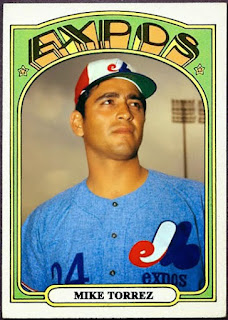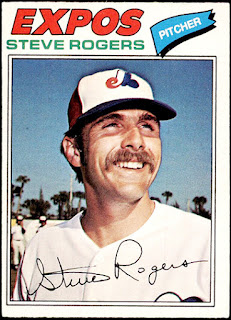Friday, February 7, 2025
REVISITING MY MISSING IN ACTION- 1974 JOE GILBERT
Wednesday, November 27, 2024
THE WHOLE NINE: SERIES 2- NOT REALLY MISSING IN ACTION: 1980 TIM RAINES
Friday, November 1, 2024
OPC IMAGE VARIATION: 1977 TONY PEREZ
Thursday, October 17, 2024
REVISITING A POST FROM 2015: "THEN AND NOW" 1974 FELIPE ALOU
Monday, September 2, 2024
OPC IMAGE VARIATIONS: 1977 WOODIE FRYMAN
On the blog today, we take a closer look at another OPC to Topps image variation, this one the 1977 differences for Woodie Fryman's cards:
Thursday, August 1, 2024
REVISITING A POST FROM 2015: MISSING 1972 MIKE TORREZ
Wednesday, July 3, 2024
REVISITING A POST FROM 2013: 1975 GARY CARTER DEDICATED ROOKIE
On the blog today, we revisit a post from October, 2013, my 1975 "Dedicated Rookie" for one of the all-time great catchers, Gary Carter:
Today's player, Gary Carter, was a former teammate of my first subject in this thread (Andre Dawson), part of that young talented Montreal Expos roster in the late-70's/early-80's.
In 1975 Carter made his first card appearance on the multi-player card you see below (#620).
It was an awesome set with some fantastic rookies (Brett, Yount, Lynn, Hernandez) and all-time legends winding down their careers (Aaron, B. Williams, Ron Santo, F. Robinson), so really I'm not trying to complain about it here.
However as I stated with the first post on this thread, I was never a fan of these multi-player rookie cards. Looking back on them now it's incredible to see how many of the players depicted never even made it up to the Majors in the future. Wasted space in my eyes (the 1977 set was particularly brutal in this respect).
Sadly Gary Carter was picked by Topps to be on one of these cards, so we also have the "un"legendary Dan Meyer, Marc Hill and Leon Roberts taking up space on what should have been a classic card of the best catcher in the 1980's and eventual Hall of Famer.
But today, allow me to imagine what a "dedicated" rookie card of Gary Carter in 1975 could have looked like had Topps issued one.
Instead of using one of those "Gary Carter-like" smiling poses we're used to, I found a slightly more serious shot of him posing at-bat. Just seemed nice and different for a change.
Sure you still had Carlton Fisk producing in the American League, but Carter really took over as the top backstop and held onto that title for pretty much the rest of the decade.
This was a guy who had nine seasons of 20+ homers and four 100+ R.B.I. seasons as a catcher. Not too shabby!
After finishing second in Rookie of the Year voting in 1975, Carter also went on to have 11 All-Star game nods, five Silver Slugger awards, three Gold Gloves and seven seasons where he garnered M.V.P. votes, finishing in the Top-10 four times.
By the time he retired after the 1992 season, he finished with 2092 hits, 324 home runs and 1225 runs batted in.
Needless to say Cooperstown came calling, and in 2003 he easily got voted in after being selected on 387 of 496 ballots, securing his place in baseball history forever.
However, sadly years later Carter was diagnosed with brain cancer, and despite undergoing aggressive treatment he succumbed to the disease about nine months later in February of 2012.
A tragic and shocking loss for the baseball world to say the least.
Friday, May 24, 2024
OPC IMAGE VARIATIONS: 1977 JACKIE BROWN
Monday, April 29, 2024
OPC IMAGE VARIATION: 1977 PETE MACKANIN
Good day all!
Monday, March 25, 2024
OPC IMAGE VARIATION: 1977 BILL GRIEF
For his career, Greif started off with seven games with the Houston Astros in 1971, going 1-1 before moving on the to team he’d play most of his Big League tenure for, the San Diego Padres.
Beginning in 1972, Greif would put in just over four season with San Diego, starting the first three before being moved to the bullpen in 1975.
His best year would be 1973 when he would go 10-17 on a hard-luck Padre team, pitching to a nice 3.21 earned run average over 36 appearances, 31 of them starts, tossing three shutouts while striking out 120 batters.
By the time he was done, he finished his career with a record of 31-67 over 231 appearances, with a 4.41 ERA in 715.2 innings, with five shutouts and 19 saves between 1971 and 1976.
Monday, February 19, 2024
OPC IMAGE VARIATION- 1977 ELLIS VALENTINE
Good day all!
Tuesday, January 2, 2024
OPC IMAGE VARIATIONS: 1977 BARRY FOOTE
The next OPC to Topps image variation profiled here on the blog will be the 1977 cards of former catcher Barry Foote, with Topps coming out the winner in my humble opinion:
Tuesday, December 26, 2023
OPC IMAGE VARIATIONS: 1977 DENNIS BLAIR
Here's a strange one for you all today, a closer look at the image variation on former Montreal Expos pitcher Dennis Blair's 1977 Topps and OPC cards:
Monday, December 11, 2023
OPC IMAGE VARIATIONS: 1977 CHIP LANG
He’d be back on a Major League mound the following season, appearing in 29 games for Montreal, with two of them starts, going 1-3 with a 4.19 ERA over 62.1 innings of work, striking out 30 but walking 34.
He would go on to play two years in the Minors, for both the Montreal and Pittsburgh Pirates organizations, but never get back to the Big Leagues, finishing up with those 30 appearances in 1975/1976, with a record of 1-3 along with a 4.36 ERA in 64 innings pitched.
Tuesday, December 5, 2023
OPC IMAGE VARIATIONS: 1977 DAVE CASH
Today on the blog we take a look at another OPC/Topps image variation in the 1977 sets, this time for Dave Cash of the Montreal Expos:
In those three seasons Cash averaged over 200 hits a season, along with a .300 average while playing pretty much every single game, even setting the MLB record (since broken) of 699 at-bats during the 1975 season.
He’d sign with the Montreal Expos in the Winter of 1976 as a Free Agent, and would have one more very good year in 1977 before quickly having his career turn South.
All told, Cash finished with a very nice .283 career average, with 1571 hits over 5554 at-bats and 1422 games between 1969 and 1980, stealing 120 bases and scoring 732 runs.
Wednesday, November 8, 2023
1971 TOPPS ROOKIE ALL-STARS: CARL MORTON
The next unreleased 1971 Topps Rookie All-Star card we spotlight here on the blog will be the N.L.'s top rookie of the 1970 season, former Montreal Expos pitcher Carl Morton, who took home top honors:
Wednesday, November 1, 2023
OPC IMAGE VARIATIONS: 1977 JOE KERRIGAN
Good day all.
Monday, October 2, 2023
OPC IMAGE VARIATION: 1977 STEVE ROGERS
Today on the blog, we take a look at another image variation between Topps and their North-of-the-border OPC cousin, this time the 1977 cards for Montreal Expos ace Steve Rogers:
I always felt he should have won the award over Garry Mathews actually, completing seven of his starts and giving up only 23 earned runs while striking out 64.
Of course Rogers would go on to become an all-star pitcher, having five such nods over his career, while finishing second in the Cy Young vote in 1982, then coming in fourth the following season.
Arm trouble cut his career somewhat short at the age of 35 in 1985, as he retired with a record of 158-152, pitching on some tough losing teams early in his MLB tenure.
Nevertheless, the man put in some stellar performances on a Big League mound, leading the league in shutouts twice, ERA in 1982, and ending up with 37 shutouts over 399 appearances.
Saturday, May 13, 2023
EXPANDED LEAGUE LEADERS: 1979 N.L. ERA
On the blog today, we move on to the National league and their top three ERA pitchers of 1978, displayed on a 1979 "expanded league leader" card:
Sunday, April 30, 2023
EXPANDED LEAGUE LEADERS: 1979 N.L. VICTORIES
On the blog today, we move on to the National League’s top winners for 1978, shown on a 1979 “expanded league leader” card from my long-running thread:
We begin with the 40-year-old wonder, Gaylord Perry, who would stun everyone with a season like no other for a man of his age, taking home the Cy Young Award that year by going 21-6 in his first season with the San Diego Padres.
Perry was just brilliant that year, leading the league with his 21 wins, while pitching to an excellent 2.73 earned run average, with two shutouts and five complete games while tossing 232.2 innings.
It was the 14th season in a row that Perry topped 200 innings, while also reeling off five 300+ inning campaigns during the stretch. Just incredible!
By taking home the Cy Young in 1978, he became the first pitcher in major League history to win the award in both leagues, previously winning the award in 1972 when he posted 24 wins for the Cleveland Indians.
In second place with 20 wins, another pitcher who had a very successful first season with his new club, Ross Grimsley, who had what turned out to be the best year of his career in 1978 in his first year with the Montreal Expos.
Grimsley went 20-11 for Montreal that year, with a 3.05 ERA over 263 innings in 36 starts, with three shutouts and 19 complete games, looking like an excellent pick-up for the franchise.
Sadly however, Grimsley would begin to deal with injuries the following season, winning only 10 games in 1979, and lasting only parts of the next three years before retiring for good, winning only seven games between 1980 and 1982
In third place tied with 19 wins apiece, the Atlanta Braves Phil Niekro and the Los Angeles Dodgers Burt Hooton, who both had very nice seasons for their respective teams.
For Niekro, the 39-year-old just missed his third 20-win season by going 19-18 over 44 appearances, 42 of them starts, posting a 2.88 ERA over 334.1 innings while tossing four shutouts and completing 22 games.
He would follow that up in 1979 by becoming like Perry, a 20-game winner at that age, famously winning 21 games while also LOSING 20 games, though by no means his own fault, posting a very nice 3.39 ERA while throwing an amazing 342 innings for Atlanta.
If that wasn’t enough, it’s mind boggling that he was STILL to go one for another eight years before retiring after the 1987 season, pitching until he was 48! Just amazing.
For the Dodgers’ Hooton, the solid starter who is pretty much forgotten these days, he won a career-best 19 games that season, helping the Dodgers make their second-straight World Series, posting a very nice 2.71 ERA over 32 starts with three shutouts and 10 complete games, easily the best season of his 15-year career that began in 1971 with the Chicago Cubs.
By the time he hung them up after a brief stint with the Texas Rangers in 1985, he’d end up with 151 wins and a very nice 3.38 ERA over 480 games, 377 of those starts, striking out just under 1500 batters in that time.
Next week, the American League’s top winners of 1978!FOLLOW ME ON TWITTER...
Everything baseball: cards, events, history and more.











.jpg)








.jpg)
.jpg)












